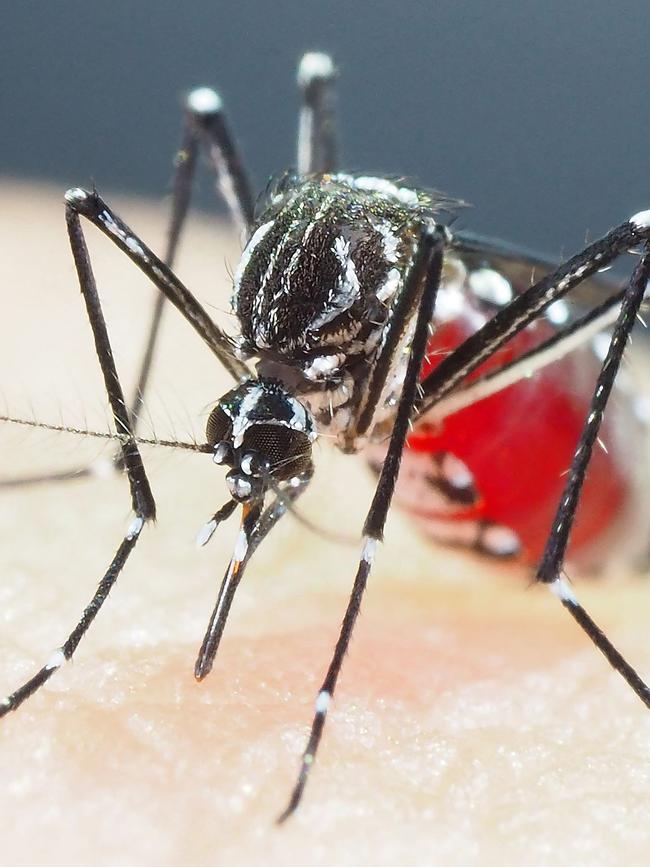Murray Valley encephalitis mosquito virus spreads in northern Victoria
Authorities have warned residents of northern Victoria to take precautions against mosquito bites as detections of a rare virus carried by the insects continue to rise.
Mildura
Don't miss out on the headlines from Mildura. Followed categories will be added to My News.
The chance of human infection of a serious mosquito-borne illness in coming weeks is “very high”.
The Department of Health recently confirmed cases of the Murray Valley encephalitis mosquito virus in the Loddon and Indigo local government areas, after it first emerged in parts of Mildura and Bendigo in early January.
At the weekend, the department said detections had increased in northern Victoria and posed a “significant risk” to residents, especially those in Mildura, who were warned to take precautions against mosquito bites.
It is the first time the virus, which can seriously affect the central nervous system, has been detected in Victoria in more than a decade of surveillance.
Symptoms include fever, headache, nausea, vomiting and muscle aches.
Health authorities believe the emergence of the virus is likely linked to recent rainfall and flooding.
The virus, for which there is no vaccine, has also been detected by NSW authorities in Menindee, north of Mildura.
Victoria’s deputy chief health officer, Associate Professor Deborah Friedman, said earlier that while no human cases had emerged, residents in northern Victoria needed to be on high alert.
She said symptoms of the virus typically emerged seven-to-12 days after exposure.
“These detections mean there is an imminent risk to human health, so we are urging people in northern Victoria to take immediate steps to reduce their exposure to mosquitoes,” she said.
“Avoid being outdoors, especially at dusk and dawn, cover up with light-coloured, long-sleeved, loose-fitting clothing, regularly apply insect repellent, and get rid of water that mosquitoes breed in around your home.”

The Loddon shire, near Echuca and Bendigo, contains townships including Bridgewater, Inglewood, Wedderburn, Serpentine, while the Indigo shire, near Wangaratta and Wodonga, includes Beechworth, Rutherglen and Chiltern.
According to NSW Health, the primary hosts of MVE virus are waterbirds such as herons and egrets and the virus is spread from infected animals to humans by mosquitoes.
Murray Valley encephalitis virus is not spread between people.
Mildura council development services manager Andrew Millen said there was no treatment for Murray Valley encephalitis so it was best to be cautious.
“Given there is no effective treatment or vaccine for MVE, preventing mosquito bites is the best protection against MVE virus,” he said.
Human cases of the virus are rare, and it cannot be transmitted between humans, or caught by touching an infected animal or eating animal products.
While most people who catch the virus develop no visible symptoms, in more serious cases people can develop meningitis or encephalitis and may experience symptoms including severe headache, neck stiffness, sensitivity to bright lights, drowsiness, confusion, seizures, loss of consciousness or coma.
Anyone with these symptoms is encouraged to seek medical care as the infection can result in lifelong neurological complications or death.
Ms Friedman said people who spent a lot of time outdoors had a higher risk of exposure, as well as people who lived near the Murray River.
“People with increased exposure to mosquitoes have a higher risk of infection. These include people who work, live or spend time outdoors in rural or regional Victoria, particularly inland riverine regions and extending up towards the Murray River,” she said.
“The best prevention is to protect against mosquito bites.
“Cover up – wear long, loose-fitting, light-coloured clothing, use mosquito repellents containing picaridin or DEET on all exposed skin, limit outdoor activity if lots of mosquitoes are about, remove stagnant water where mosquitoes can breed around your home or campsite,” she said.




